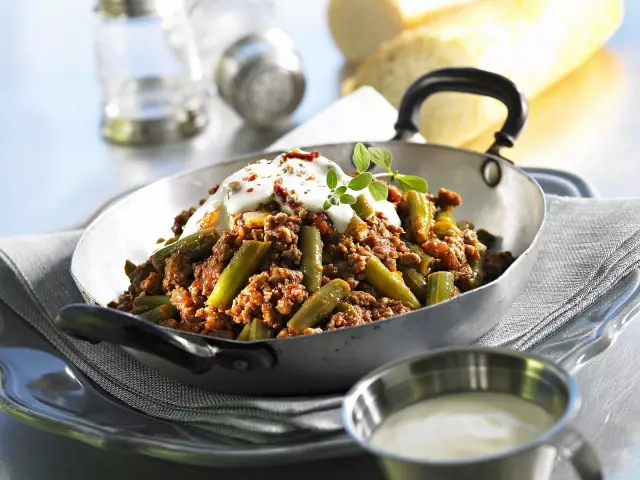2025 Author: Jasmine Walkman | [email protected]. Last modified: 2025-01-23 10:18
The beans is a species of the legume family. It was brought to Europe at the time of the great geographical discoveries. It is grown for home culture and food around the world. The homeland of this plant is South America, but it can be grown practically anywhere. It was cultivated before the Incas, and was brought to Europe by one of the expeditions of Christopher Columbus. Due to its high yield and easy cultivation, it spread throughout Europe and the European colonies of Asia until the end of the 16th century.
Beans are an annual creeping plant with fruits in the form of peppers, also called pods or beans with a kidney shape. The fruit is formed by two carpels, between which there is a tough membranous septum to which the seeds are attached. More than 200 types of beans are known, and the differences between the varieties are in the type of pepper, color and taste of the seeds.
Legumes are sown in early spring, and it is important not to bury them at great depths due to the way the legumes penetrate the soil. It is green until the beginning and middle of summer, as part of the harvest is cooked in this state, and then ripens and is ready for harvest. It is necessary to leave it for a while in the sun or in a dry and airy place for a few days after it has been picked with the pods, in order to dry it well and keep it for consumption next year.
The types of beans are many:
- Bob Azuki - is a red Asian bean, called by the Japanese the king of legumes, because it is easily digested and boiled very quickly. There is also a black version of the common azuki bean. In Asian cuisine, it is used whole, ground into flour or for making red bean paste. It is a good addition to rice and salads;
- Small white beans - in the US Navy it is known as navy bean, because after 1800 it became one of the main foods of sailors. It is difficult to digest and difficult to digest. Suitable for stews, salads and soups;
- Large white beans - most often used for salads;
- Bob Canelini - Italian variety with a very good taste, which remains slightly raw even after fully cooked. In Italy it is used to make traditional Minestrone soup and various salads;
- Lima beans / oil beans, Madagascar beans / - was discovered in Peru in the early 16th century. The grains are round, with a pronounced kidney-shaped shape, its inside is light green and is much more difficult to digest than other species. It has a very oily taste and is suitable mainly for soups and stews;
- Bob mung beans are small and can be green, yellow or red, and the inside is yellow. It is most often used to make bean sprouts. Widely used in China and India. It does not soak before cooking and has a delicate texture, and its taste is slightly sweet;
- Bob Pinto - in the dry state is beige in color with brown spots, in the process of cooking acquires a pinkish-brown color. It is a mandatory ingredient in a number of Mexican dishes;
- Bob Flajolet - the grains are small, slightly greenish, with a delicate aroma and taste. In France, it is used to make salads and as a side dish to lamb;
- Black beans - is widespread in Mexico and the southern United States. It is one of the main ingredients of both the Caribbean and Latin America. Its nipples are black and the inside is creamy. It has a slightly sweet taste and is suitable for salads and soups;
- Red Mexican bean - its grains are small, round and dark. It is mainly used for cooking chili and stews.
Recommended:
The Black Sea Mackerel And Two Species Of Sturgeon Have Disappeared From The Waters Of Bulgaria

The population of the Black Sea mackerel , which was located on the territory of the Black Sea, is already past. These are the words of the hydrobiologist and ichthyologist Pencho Pandakov, an expert, a member of the Balkanka Association. The hydrobiologist also notes that there is no other than mackerel two species of sturgeon who inhabited the waters of the Danube.
The Right Spices For Green Beans And Beans

There is hardly a more popular Bulgarian national dish than ripe beans, regardless of whether it is prepared as a soup, stew or in a casserole and whether it is lean or with meat. It is one of the most commonly used legumes in cooking, but unfortunately, if it is not prepared properly or with the wrong spices, the beans can quickly upset you.
Salmon - Species, Composition, Storage And Benefits

Salmon is an unsystematic group of fish belonging to the Trout family. It migrates, spawning in freshwater pools, and after a while the small fish move into the ocean. Salmon can easily be found in June, when the new catch begins to be offered directly by fishermen.
Suitable Spices For Beans And Beans

The secret of the delicious dish lies not only in the duration of the tolin processing, but also in the spices and their quantity. You know that any dish cooked on low heat for a long time becomes extremely tasty. Often, however, the lack of a certain odor is felt, which can spoil the whole pleasure of eating.
Nutritional Values of Beans And Green Beans

With the name beans in our country the whole group is designated legumes , but when the name is used, it is always about beans and green beans . Ripe beans are the name of the seeds of the plant that are used for food, and green beans are understood as green seeds and green bean pods.

